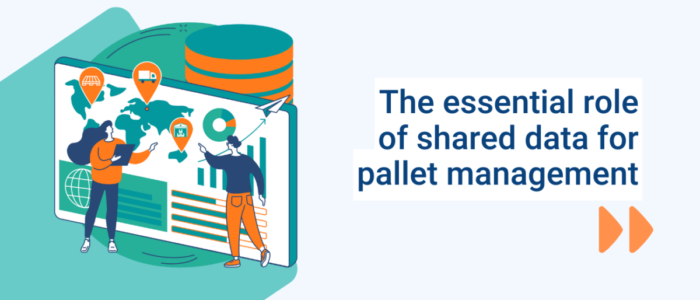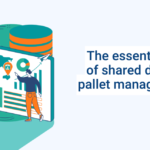The essential role of shared data for pallet management
The essential role of shared data for pallet management
Your transport data is scattered across a multitude of tools and are often underutilized?
You’re not alone!
Data management, a priority issue for the supply chain
With globalization, the acceleration of e-commerce and the fragmentation of flows, the supply chain is undergoing major changes. This implies having to process more and more information shared with a multiplicity of players. Managing transport data is an important challenge for organizations and concerns all links in the chain, from the supplier to the final recipient.
As far as data control is concerned, handling media is no exception to the rule, especially those that are returnable, such as the Euro pallet. In theory, the carrier should collect the number of empty pallets equivalent to the quantity delivered, and return them to the shipper. In reality, this is rarely the case, and collecting data on the exchange of carriers quickly becomes a headache.
- Which carrier is it?
- How many pallets did he load at the beginning?
- How many did he unload on arrival? …
To ensure the smooth running of the logistics chain, just as for goods, it’s essential to rigorously manage the flow of equipment.
The risks of siloed pallet flow management
In transportation-related activities, Excel remains a good tool to start and install processes internally. Companies use it mainly to have a history of basic information. But if each logistics partner uses its own spreadsheet to manage pallet accounts, then flow management remains imprecise and data is difficult to use.
And the more exchange partners there are, the more complex, and it becomes impossible to compile the data and obtain a consolidated view at a given time.
In concrete terms, the silo mode of operation has a direct impact on the cash flow of companies. It’s estimated that a shipper loses on average between 10% and 15% of its media, a rate that can reach up to 30% in some cases.
As an example, a manufacturer who ships 1 million pallets per year, as part of its activities, can suffer from an outstanding amount reaching 20 million euros*. A colossal financial challenge that companies don’t always realize.
Beyond the financial aspect, the loss of handling media represents a waste of the wood resource and thus a disaster on the environmental level. While a better visibility on the flows would allow to reintroduce the packaging in the logistic chain, to increase their reuse and to improve considerably the rate of reverse (to know more, read this article)
Would you like to know how much you can save on your pallet pool thanks to shared data? 👉 In a few clicks, calculate your R.O.I.
In addition, pallets are often managed on a just-in-time basis, especially during peak periods. Often, managers are forced to battle with their partners to try to recover available media pools, assuming they have sufficient visibility into the location of their inventory. These situations create stress and represent a potential risk to the relationship with transport partners.
In addition, pallets are often managed on a just-in-time basis, especially during peak periods. Often, managers are forced to battle with their partners to try to recover available media pools, assuming they have sufficient visibility into the location of their inventory. These situations create additional stress and represent a potential risk to the relationship with transport partners.
Finally, the control of equipment management undeniably depends on the quality of the data. In this area, a specialized digital platform can make the difference, as it allows precise analysis of information and helps to control flows.
Real-time data sharing helps improve packaging management
Automation of repetitive tasks with little added value, improved traceability, better collaboration between teams, there is no shortage of benefits from digitalized packaging management! Here are some examples:
-
Real-time visibility ⌛
Thanks to collaborative platforms, data is shared in real time between all partners, so everyone has the same level of information. The reliability and consistency of the indicators make it easier to manage the pallet pool and bring more agility in decision making.
-
Transparency and consensus between partners 🤝
Unlike the declarative system, the collaborative mode allows to create a consensus mechanism. There is no need to wait for the end-of-month tally to reconcile the information between partners. Each actor can consult the accounts and debts at any time, and schedule the return transport of pallets accordingly. The reverse is optimized with a rate close to 100%!
-
Reduction of the administrative burden 📃
The data is only fed once and benefits the exchange partner. This avoids double entry and eliminates repetitive and time-consuming manual tasks through automatic features. The time spent managing pallets is considerably reduced, i.e. a reduction of 20 to 30% for the manager.
-
Centralization of information and documents 🖥️
For each operation entered, it’s possible to directly upload the proof of delivery (CMR) on the platform. The documents are instantly shared and can be consulted by your partners. No more sending proof of delivery by email!
In short, by removing silos, improving visibility and data sharing between partners, digitalization is proving to be a powerful transformative lever in reusable packaging management. It can increase reuse rates and eliminate waste throughout the supply chain. Equipping yourself with a digital platform to manage pallets is a guarantee to recover at least 15% more media, thanks to the quality of the information produced.
👉Do you want to gain agility and efficiency in the management of your aggregates? Call on our experts.
They will support you step by step in the implementation of your project
*price of a new Eu pallet between 10 and 14 € (February 2023)







